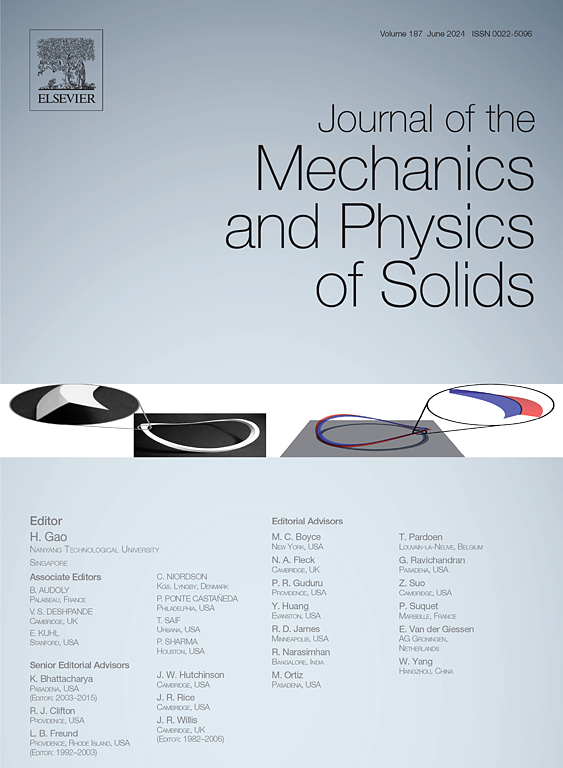双稳态柔性机械超材料中具有固定临界的异常尺寸效应
IF 6
2区 工程技术
Q2 MATERIALS SCIENCE, MULTIDISCIPLINARY
引用次数: 0
摘要
当结构变形以低能变形方式为主时,在小尺寸下,结构随着尺寸(单元数)的增加而硬化。随着有限结构的衰减长度收敛到与尺寸无关的特征量,这种异常行为最终会消失,但异常行为消失的具体临界点仍然无法准确而简洁地描述。在双稳链的两种稳定状态下,我们观察到异常尺寸效应具有恒定和振荡临界(不均匀变形的比例),这两个临界完全分开了刚度变化的增减区间。由于两种稳态之间隐含的对称性,它们是相互关联的。另一方面,由于在两种稳态下的叠加模态相反,它们也被区分开来。具体而言,恒定临界对应于竞争机制实现的异常尺寸效应,而振荡临界则揭示了新机制(抵消机制)实现的异常尺寸效应。在由抵消机制实现的异常尺寸效应中,完全抵消变形所产生的奇异特性使其具有很强的鲁棒性。这种鲁棒性体现在异常效应不再局限于线性小变形,而在非线性大变形中仍然可以稳定地观察到。我们的研究在定量层面上重新解释了异常尺寸效应,提出的抵消机制扩大了这种异常效应的可能应用范围。本文章由计算机程序翻译,如有差异,请以英文原文为准。
Anomalous size effects with fixed criticality in bistable flexible mechanical metamaterials
When the structure deformation is dominated by the low-energy deformation mode, the structure hardens with the increase in the size (number of units) at small sizes. This anomalous behavior will eventually disappear with the decay length of the finite structure converging to a size-independent characteristic quantity, but the specific critical point at which the anomalous behavior disappears still cannot be accurately and concisely described. Here, under two steady states of the bistable chain, we observed anomalous size effects with constant and oscillating criticality (the proportion of inhomogeneous deformation), two criticalities exactly separate the increasing and decreasing intervals of stiffness variation. They are interrelated due to the implied symmetries between the two steady states. On the other hand, they are distinguished because of the opposite superposition modes under the two steady states. Specifically, the constant criticality corresponds to the anomalous size effect achieved by the competition mechanism, while the oscillating criticality reveals an anomalous size effect achieved by the new mechanism (cancellation mechanism). In the anomalous size effect achieved by the cancellation mechanism, the singular characteristics generated by the completely cancelled deformation make it very robust. This robustness reflects in that the anomalous effect is no longer limited to linear small deformation, but it can still be observed stably in nonlinear large deformation. Our study reinterprets the anomalous size effect at a quantitative level, and the proposed cancellation mechanism expands the possible application range of this anomalous effect.
求助全文
通过发布文献求助,成功后即可免费获取论文全文。
去求助
来源期刊
CiteScore
9.80
自引率
9.40%
发文量
276
审稿时长
52 days
期刊介绍:
The aim of Journal of The Mechanics and Physics of Solids is to publish research of the highest quality and of lasting significance on the mechanics of solids. The scope is broad, from fundamental concepts in mechanics to the analysis of novel phenomena and applications. Solids are interpreted broadly to include both hard and soft materials as well as natural and synthetic structures. The approach can be theoretical, experimental or computational.This research activity sits within engineering science and the allied areas of applied mathematics, materials science, bio-mechanics, applied physics, and geophysics.
The Journal was founded in 1952 by Rodney Hill, who was its Editor-in-Chief until 1968. The topics of interest to the Journal evolve with developments in the subject but its basic ethos remains the same: to publish research of the highest quality relating to the mechanics of solids. Thus, emphasis is placed on the development of fundamental concepts of mechanics and novel applications of these concepts based on theoretical, experimental or computational approaches, drawing upon the various branches of engineering science and the allied areas within applied mathematics, materials science, structural engineering, applied physics, and geophysics.
The main purpose of the Journal is to foster scientific understanding of the processes of deformation and mechanical failure of all solid materials, both technological and natural, and the connections between these processes and their underlying physical mechanisms. In this sense, the content of the Journal should reflect the current state of the discipline in analysis, experimental observation, and numerical simulation. In the interest of achieving this goal, authors are encouraged to consider the significance of their contributions for the field of mechanics and the implications of their results, in addition to describing the details of their work.

 求助内容:
求助内容: 应助结果提醒方式:
应助结果提醒方式:


